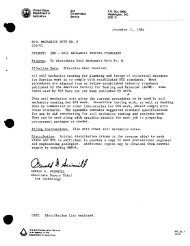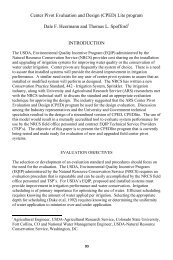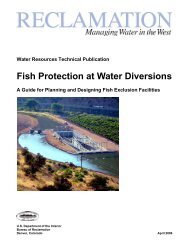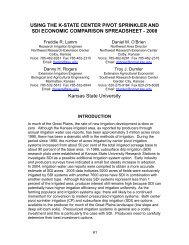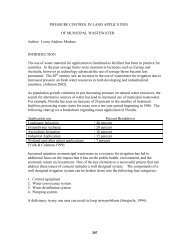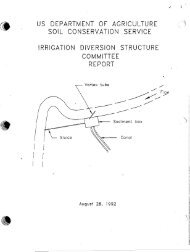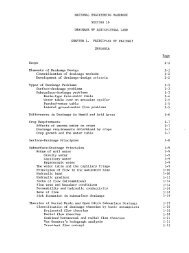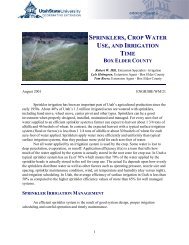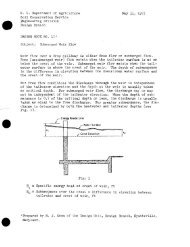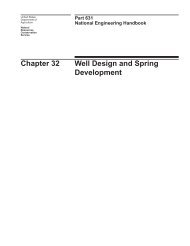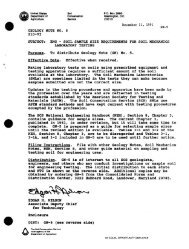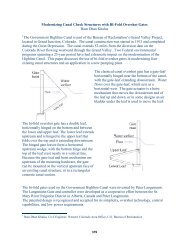Chapter 11: Sprinkle Irrigation - NRCS Irrigation ToolBox Home Page
Chapter 11: Sprinkle Irrigation - NRCS Irrigation ToolBox Home Page
Chapter 11: Sprinkle Irrigation - NRCS Irrigation ToolBox Home Page
You also want an ePaper? Increase the reach of your titles
YUMPU automatically turns print PDFs into web optimized ePapers that Google loves.
sign computations should be based on field or test<br />
facility data. Field evaluation techniques for estimating<br />
the uniformity of periodic-move, traveling,<br />
and center-pivot sprinklers are presented in the following<br />
sections. However, when test data are not<br />
available in general planning for the most common<br />
periodic-move sprinkler spacings, tables <strong>11</strong>-5<br />
through <strong>11</strong>-8 can be used to obtain estimated<br />
values of CU for various wind conditions and application<br />
rates.<br />
The average uniformity of the catch data of two<br />
irrigations is always higher than the average uniformities<br />
of the two irrigations measured individually,<br />
because of changes in wind and water jets.<br />
Uniformity can be further improved by positioning<br />
the laterals midway between the previous settings<br />
for alternate irrigations. This practice is called alternate<br />
sets, and it halves the lateral spacing for<br />
the pair of irrigations. The uniformity of a pair of<br />
irrigations using alternate sets can be approximated<br />
by:<br />
cu, = lo m<br />
or<br />
For gun or boom sprinklers CU values of 60 to 75<br />
percent are typical for low and moderate wind conditions.<br />
These sprinklers are not recommended for<br />
use in high winds. By using alternate sets along the<br />
lateral or between laterals when practical, CU,<br />
values of about 80 percent can be obtained in the<br />
central portion of a field.<br />
For traveling sprinklers the effective spacing<br />
along the tow path that corresponds to the lateral<br />
is zero. Thus, the expected CU in the central portion<br />
of the field and in low to moderate winds<br />
should be similar or slightly better than the CU, of<br />
80 percent for periodic-move gun or boom sprinklers.<br />
Center-pivot and linear-move systems produce<br />
high uniformities because the sprinklers are usually<br />
relatively close together on the moving laterals.<br />
With proper nozzling CU $ 94%, DU > 90% can be<br />
expected in the area under the system hardware in<br />
relatively level fields. The same high uniformities<br />
can be maintained even on steep, undulating fields<br />
if flow control nozzle sprinklers or other means af<br />
countering elevation effects by regulating pressure,<br />
flow, or system speed are used. When large end gun<br />
sprinklers are used on center-pivots, the average<br />
CU of the whole irrigated area drops about 1 percent<br />
for each 1 percent of area covered past the end<br />
of the hardware.<br />
Water Loss<br />
Although efforts are often concentrated on evaluating<br />
systems by dealing with uniformity problems,<br />
loss of water also reduces system efficiency. Frequently,<br />
designers assume that systems will be perfectly<br />
managed and losses will almost be elirninated,<br />
but this is seldom the case. Overwatering is<br />
perhaps the greatest cause of loss in any irrigation<br />
system. Other major causes of losses associated<br />
with sprinkle irrigation are:<br />
1. Direct qvaporation from droplets and from wet<br />
soil surfaces and transpiration from unwanted vegetation.<br />
2. Wind drift,<br />
3. Leaks and system drainage.<br />
Wind drift and evaporation losses may be less<br />
than 5 percent when irrigating a crop with a full<br />
vegetative canopy in low winds. More commonly,<br />
wind drift and evaporation losses range between 5<br />
and 10 percent. However, under very severe conditions<br />
they can be considerably greater. Figure<br />
<strong>11</strong>-17 has been developed as a guide for estimating<br />
the effective portion of the water applied that<br />
reaches the soil-plant surface (R,). The values given<br />
for effectiveness for different potential evapotranspiration<br />
rates are based on an assumed full plant<br />
canopy and 24-hr applications. The fine-spray<br />
curves are based on 3<strong>11</strong>6-in nozzles operating at 60<br />
psi in a 40- x 60-ft spacing. The coarse spray is for<br />
3<strong>11</strong>6-in nozzles operating at 30 psi in a 30- x 60-ft<br />
spacing.<br />
TO use fimre <strong>11</strong>-17, it; is necessary to know<br />
whether the spray from a sprinkler is coarse, fine,<br />
or somewhere in between. To make this determination<br />
a coarseness index (CI) is used. This index can<br />
be calculated by the following method:<br />
where<br />
P = Nozzle operating pressure (psi)<br />
B = Nozzle size (64th~ of an inch)



